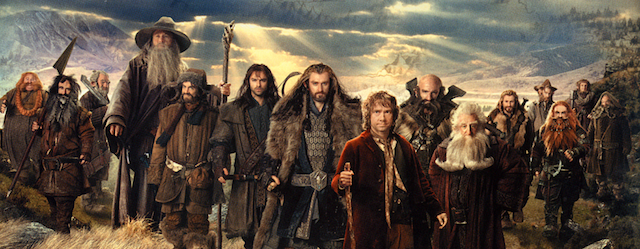
“From great things come small beginnings”– Misquoted American proverb
In the wee small hours of Friday’s snowpocalypse (known as Ragnafrost in other regions), a thought crossed my mind, one I'll attempt to transcribe in as lucid, and complete a manner as can be managed:
Mmmuuurrrrgh, go back to sleep. It is too early for this waking up nonsense. I should see what time it is to make sure it really is too early for said nonsense. No, don’t do that, that’ll just encourage you to get up; this bed is too comfy to risk that. Wasn’t I supposed to do legs at the gym today? That twitter picture made a pretty convincing case to do so…but this nirvana of warmth and goose down sounds a whole lot more enjoyable than squats. I’ll just go get some work done downtown later, that’s at least a good hour's worth of walking. The weather’ll make it a workout. This much snow outside, it’s going to be a real jour-
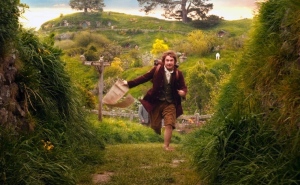
And that was when I realized that The Hobbit: An Unexpected Journey had been out for more than a month, and I still hadn’t seen it. Worse, the window to watch it in theatres (which is kind of important for this type of movie) was rapidly closing. Checking the local listings, my only option was the very nice (and way too expensive) theatre that had an IMAX 3D showing. Yes, it was far, and yes, $20 is more than anyone in their right mind should pay for a movie ticket, no matter how maxed the I-s, or three the D-s. But I tread the snow, and I dropped the cash anyway. It’s The Hobbit for crying out loud.
A little bit first on my relationship with The Lord of the Rings films: I love ‘em. I still remember seeing Fellowship for the first time (also in Toronto oddly enough), and it was right around the time that the Balrog showed up in the Mines of Moira that a franchise lifer was born. At most, I usually make it six months without watching one of the movies, which more often than not leads to popping in the other two soon after. It’s a generational thing I suppose. Most of my friends are big fans of the LotR movies as well, so it’s always been incredibly easy to have one of the films on in the background while hanging out, having a drinking session (and a subsequent hangover session), or doing some household chores that could use the epic sweep of a Howard Shore score. Point being: I’m a dyed-in-the-wool supporter of the trilogy.
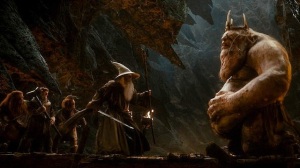
The foundation of my allegiance to the franchise owed a great deal to both how old I was when first watching the films, and my near complete obliviousness to the source material itself. I’m not even sure I was really aware of The Lord of the Rings until the advertising for the first movie came out, though vague memories of a fellow classmate’s book report on all ~2000 pages of the series might have biased me against it to begin with (it was my arch-6th-grade-nemesis giving the report, so if he liked something, it had to be stupid). I had read The Hobbit years earlier, but forgotten most of it by 2001, though didn’t forget that I had enjoyed it. The movie memories have stuck, though: I remember the theatre trip for each original viewing, and the first re-watches on DVD (or 2-cassette VHS, in the case of Return of the King).
So, like a lot of people who hold Peter Jackson’s magnum opus fairly near and dear to their heart, I was pretty nervous through the entire build-up towards, and production of, The Hobbit. Jackson seemed done with Tolkien's universe, which was completely understandable: the three movies he made were massive critical and commercial successes, setting up one of the toughest acts to follow in cinematic history. Making his grand return to Middle-earth using a 300-page children’s book as a guide seemed like a daunting task, to say the least. Later claiming he wanted to make two movies out of said 300-page children's book seemed like a fool’s errand. But upon hearing a 300-page children's book was going to be the basis for atrilogy of films,you started to worry that Jackson had set out to film the world's most expensive career suicide note.
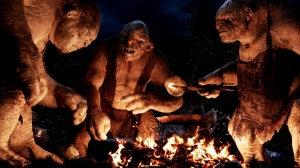
The reviews that came out when part I was released confirmed many of the above stated fears. Despite dipping into the Tolkien appendices for extra material, critics found An Unexpected Journey too thinly stretched, and overly reminiscent of the first trilogy. Fans were kinder, recognizing that The Hobbit was a different kind of beast, and probably had no chance of escaping the shadow of the LotR movies. A call went out for adjusted expectations. After my viewing yesterday, I feel like I side a bit more with the film’s detractors than its supporters, even though I’d say I liked it overall.
That’s not how I felt for the first fifteen minutes mind you. When the camera opened up on Ian Holm as Bilbo, and a new twist on those familiar musical strings started playing in the background, I was lucky my bulky IMAX glasses were hiding the embarrasing doofus grin that was on my face. It was like finally getting to revisit your favorite vacation spot with fresh eyes, after a decade of flipping through old photos nostalgically. There’s the Shire! Oooh, a lengthy prologue about the dwarves, and Smaug! And hey, it’s Elijah Wood! I should probably be more critical of a cameo this pandering, but who cares! Frodo!
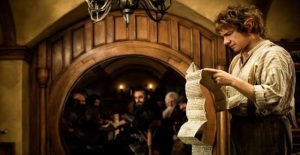
By the time the title card proper faded in, and we got our first glimpse of Martin Freeman as a young Bilbo (who gets flack for playing a typical Martin Freeman character, despite it being called for here), I was hopelessly back in Tolkien’s thrall. Gandalf showing up a moment later should have sent me into babbling fanboy overload, which it did…until he actually started talking. I was giddy to see Ian McKellen back in the role that has defined him for so many people my age, but as the two characters were having their formal introduction, something just felt off. Not so much in terms of how they were speaking, but what it was they were saying. There are fast friends, and there are friends that can transition a lesson on syntax into an invitation to go kill a dragon in under 30 seconds. For a being that’s never late, Gandalf seems to be in an awful rush to get Bilbo’s big adventure started.
Then came the lengthy dinner scene that’s become something of a litmus test for viewers, taking what must be at least a half hour to introduce the many dwarves in Gandalf’s company, setup their quest to take back the Dwarven kingdom of Erebor, and get Bilbo from housebound fuddy-duddy, to aspiring adventurer. And sure enough, the length of the sequence makes itself felt, but it provided a beautiful display of the production values that have become a hallmark of these films. The tracking shots covering more than a dozen characters of vastly different height and stature were wonderfully intricate, and the tight corridors of Bilbo’s Hobbit-hole let your eyes feast on the elaborate costumes and set design.
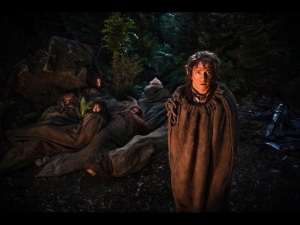
The opening act is indeed overlong, and the singing felt a wee bit out of place, but those weren’t cause for alarm. No, what did rankle was the big speech that Gandalf gives to convince the party (especially their leader, Thorin Oakenshield) to take on Bilbo as their burglar. And by big speech, I mean he bellows menacing commands as his voice drops several octaves, and takes all the light of the room. It wasn’t just that Gandalf, one of the most level-headed inhabitants of Middle-Earth, started using his spooky outdoor voice apropos of nothing, or that the scene felt like a far too blatant homage to a memorable moment from Fellowship.
What concerned me was the same thing I felt when Gandalf and Bilbo were first meeting, because in both instances, Gandalf is telling everyone what has to happen. Not in a guiding, “let me help you find your way” manner, but more of a, “here’s how this shit is going to play out, so do as I say.” He doesn’t offer Bilbo the call to adventure: he sticks one half of adventure’s cell phone in Bilbo’s ear, as if it were Óin’s hearing aid, then shouts in the other end that, yes, Mr. Baggins will be more than happy to accept the charges.
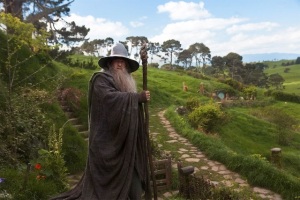
As one of the most powerful beings in the LotR universe, Gandalf is entitled to having “a good feeling” about what it is everyone should be doing, but The Hobbit upgrades his skills from that of a psychic, to a full-on author surrogate, directing events instead of guiding others along through them. A common complaint for the film is that most of the predicaments Bilbo and co. find themselves in are solved by Gandalf’s miraculous timing, and pocket full of “get out of jail free” spells. This is entirely valid, as Bilbo, the ostensible hero of the story, has about as much impact on its outcome as some of the more interchangeable dwarves. Save for the finale, his biggest scene (and arguably the best in the movie) is the game of riddles he shares with Gollum, which ends with Bilbo escaping with the one ring.
What I love about that sequence isn’t the riddles, or getting to watch Andy Serkis slip back into the milky skin of his most famous role; what sold it for me was the very end, when we see Bilbo struggling to pick whether or not to kill Gollum. We know the eventual outcome of his decision because of the original trilogy, but it doesn’t diminish the suspense that comes with watching Bilbo make an actual choice for himself. Choice was a hugely important element in LotR, as it should be in any narrative. Will Frodo accept the burden of the ring? Does Gandalf join Saruman? Will Boromir betray the fellowship? Yes, these are foregone conclusions once we’ve gotten to know the characters, and the type of narrative being told, but in context, they’re weighty turning points for those involved.
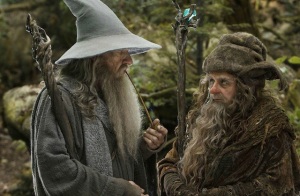
The absence of agency brings to focus that horrible balancing act most prequels are saddled with, where past events have to have importance, and weight, despite audiences knowing the eventual end to the story. If it’s done correctly, you get something like X-Men: First Class, or Rise of the Planet of the Apes, where learning about the origins of the original franchise is surprising, and entertaining in its own right. The journey really does become more important than the destination, something a bad prequel usually doesn't understand. Poor ones go out of their way to fill-in blanks no one ever cared about (like Anakin being the one who builds C3PO), or cause a studio do creative gymnastics to justify going back in time without mucking up the continuity (Fox’s major narrative justification for a Wolverine prequel: AMNESIA).
Maybe it's out of reverence to the original trilogy that An Unexpected Journey puts so much stock in devices like fate, and destiny, as opposed to actual character initiative. Perhaps the only prophecy in LotR was the “duh doy” claim that Sauron would one day return, and it doesn’t take a wizard to predict that the manifestation of pure evil needs more than a finger lobotomy to truly die. The events of An Unexpected Journey, on the other hand, exists entirely because of ancient forecasting, soothsaying, and dumb luck that gets explained away with similar narrative hokum. The dwarves move to retake Erebor because somebody figured Smaug’s rule over the Lonely Mountain must come with an expiration date, and a vital clue on Thorin’s map (a door that only opens at a specific time, on Dwarven New Year's) is rather conveniently revealed, thanks to the party arriving in Rivendell precisely when the moon's plot driving powers are at their peek.
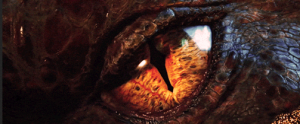
Thing is, a lot of these developments are from the book, which further illuminates the big narrative differences between The Hobbit, and The Lord of the Rings. Generally speaking, I have an inherent issue with any plot dependent on an ancient returning evil threatening the world, because it’s the laziest means of creating audience investment. It’s not like you’re going to start rooting for the giant flaming eyeball, right? But it’s about the only narrative you can do when you want to capture a world with as much expanse as Tolkien’s, which the LotR movies smartly explored in terms of breadth, not depth. The problem with An Unexpected Journey is that it’s telling a much smaller story in a setting that’s not all that new to us anymore.Taking back a mountain full of gold doesn’t really seem quite as urgent as stopping fantasy Satan, so the film tries to make the stakes more personal, which doesn’t really work out.
Bilbo and Thorin are meant to split duties as the protagonist, but the former is often pushed off to the fringes, and the latter mostly just broods while looking purposefully off into the distance. (Again, choice seems MIA for Thorin. Aragorn had to reconcile with his lineage and rise to the throne. Thorin wants it because it’s his birthright). While this is setting up overall character arcs that will probably be impactful eventually, there’s a bro-hug’s worth of payoff to be found in part I, and that’s it. Meanwhile, when he's not busy saving everyone's asses, Gandalf runs off to share ominous musings with the Middle-earth Security Council, creating an entire subplot dedicated to justifying these films in terms of the ones that came before them. It’s understandable why Jackson was tempted to bring Cate Blanchett and Christopher Lee back in for guest spots, but their scenes do little more than temper expositional groundwork laying with familiar faces.
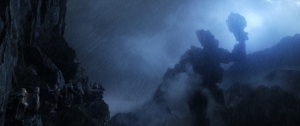
More than anything, An Unexpected Journey’s biggest flaw is the way it tries supplementing the story’s thinness with incidental excess. Whenever there’s an opportunity for something from the book to take on life as an action sequence, Jackson goes for it, even if the source is just a line of dialogue. Azog, an intensely minor figure from the book, is built up to be Thorin’s archenemy, so that this first installment has an active antagonist, but there’s no resolution to their feud, just a bunch of a chase scenes. The party can’t even climb up a mountain without 100-foot tall, granite versions of the robots from Real Steel slugging it out. The whole film boils down to a rhythm that has the company move a few inches toward their destination, get waylaid by a sudden action scene, stumble upon a few connections to the original films, and ultimately get saved in the nick of time by Gandalf. Rinse, and repeat.
It feels like you’re watching the extended edition of the movie meant for die-hard completionists, instead of the streamlined theatrical version meant to make you want to see the extended edition. The runtime is padded out with world building that focuses on superfluous details (you’ll know more about some of the swords than most of the dwarves using them), or showy cameo appearances meant to setup dangling plot threads. Were there only two Hobbit films, it’s not hard to imagine a great deal of An Unexpected Journey’s runtime condensed to a two-minute montage. With its wide cast of characters, and sporadic plotting, the film tries to build a Mount Doom out of a dozen molehills, but they never combine into anything quite so grand.
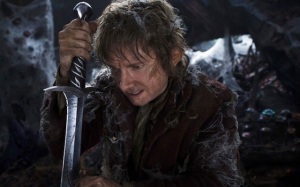
So, do we have another Phantom Menace on our hands? Hell no! I realize I just spent way longer criticizing the film than I had originally planned, but I still liked it. For as much as I can complain about the pacing and the narrative, the movie itself is entertaining from front to back. The battle scenes are exciting, and the lack of cataclysmic stakes makes for a much lighter and adventurous tone. And while the 3D adds nothing, An Unexpected Journey is a visual tour de force, just in a different way than its predecessors. The nerves of my brain governing how I react to spectacle shots have habituated to the point of uselessness at this point, but the establishing shots for the landscapes and cities frequently amazed me. The heavier reliance on green screen makes the sets less convincing than those in the films that came out a decade before, but as the humble origins of a massive mythology, it actually makes sense that The Hobbit looks more imaginative, and fantastical.
And that’s the thing: when you keep in mind the legacy it has to live up to, and the differences in the source material, The Hobbit really is a perfectly fine follow-up to The Lord of the Rings, one meant to get a whole new generation invested in Middle-earth. It’s probably my original trilogy blinders that make me think every parent should show their kids Fellowship through Return of the King before moving onto The Hobbit, but maybe when all is said and done, the prequels will be the new go-to films for developing Tolkien-ites. More than anything, I’m glad my understanding of what I loved about those original films is clearer because of An Unexpected Journey. I like my Tolkien movies to have narratives that are sweeping and grandiose, with production designs that are intimate and multilayered. The Hobbit: An Unexpected Journey flips that balance, and it didn’t work out amazingly this time, but Jackson and company still have two more shots at this. After all, I’m part of the problem: no matter how bad these movies might possibly get, I’m going to watch them. I might just make sure to pay closer attention to when Part II is in the cheap theatre, come December.
